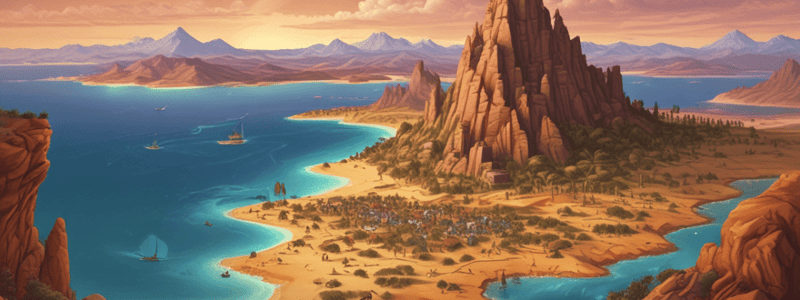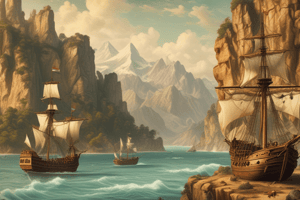Podcast
Questions and Answers
What was the main motivation for European explorers to find new water routes to Asia?
What was the main motivation for European explorers to find new water routes to Asia?
- To discover new lands and peoples
- To spread Christianity
- To establish trade routes and break the duopoly of Genoa and Venice (correct)
- To find new sources of gold and silver
What was the name given by European explorers to the region they discovered in the Americas?
What was the name given by European explorers to the region they discovered in the Americas?
- The New World
- Asia Minor
- Cathay
- Mundus Novus (correct)
What was the result of the introduction of smallpox to the Native American population?
What was the result of the introduction of smallpox to the Native American population?
- It resulted in the exchange of crops and animals between the Old and New Worlds
- It caused the near-destruction of many Native American cultures (correct)
- It led to the colonization of the Americas by Europeans
- It led to the formation of strong alliances between Native Americans and Europeans
What was the phrase that best explains the motivations of European explorers?
What was the phrase that best explains the motivations of European explorers?
What was the main reason for England's exploration of the New World?
What was the main reason for England's exploration of the New World?
What was the Columbian Exchange?
What was the Columbian Exchange?
What were the two most valuable metals in Europe during the Age of Exploration?
What were the two most valuable metals in Europe during the Age of Exploration?
Which of the following was NOT a motivation for European exploration and colonization?
Which of the following was NOT a motivation for European exploration and colonization?
What are the primary regions referred to as the Old World?
What are the primary regions referred to as the Old World?
Why is the system of naming the Old World and New World considered Eurocentric?
Why is the system of naming the Old World and New World considered Eurocentric?
What was the primary motivation for the Age of Exploration?
What was the primary motivation for the Age of Exploration?
Which of the following was NOT a country that built vast overseas empires in the New World?
Which of the following was NOT a country that built vast overseas empires in the New World?
What was the result of the intercontinental trade route established during the Age of Exploration?
What was the result of the intercontinental trade route established during the Age of Exploration?
What was known to educated people in Europe before the Age of Exploration?
What was known to educated people in Europe before the Age of Exploration?
Why were the Vikings' journeys to North America not well-known to the rest of Europe?
Why were the Vikings' journeys to North America not well-known to the rest of Europe?
Flashcards are hidden until you start studying
Study Notes
Old World vs New World
- The Old World refers to Europe, Africa, and Asia, while the New World refers to North America, South America, and the Caribbean.
- The term "Old World" primarily refers to the regions known to Europeans before the Age of Discovery.
- The Old World was home to great civilizations, including ancient Greece and Rome.
The Old World
- The most important Old World countries during the Age of Exploration were England, France, Spain, Portugal, and the Netherlands.
- These countries built vast overseas empires in the New World.
- Africa was also known to Europeans, and the Atlantic slave trade was initiated during this period.
- Asia was part of the Old World, with Europeans being familiar with western Asia, but less familiar with eastern Asia.
New World History
- The Latin phrase "Mundus Novus" was used to describe the Americas, a region new to Europeans.
- The Age of Discovery was started by men such as King Henry of Portugal and Christopher Columbus.
- The rediscovery of the Americas by Columbus in 1492 was a major revelation to Europeans.
- There were thousands of Native American cultures, some with advanced civilizations, but most were wiped out by contact with Europeans.
Modern-Day New World Countries
- Some modern-day countries that exist in the New World are:
- The United States
- Canada
- Brazil
- Mexico
- Colombia
- Venezuela
- Cuba
- The Bahamas
- Argentina
Reasons for European Exploration and Colonization
- The desire for new trade routes, silk, spices, and new crops initiated the Age of Discovery.
- Other motivations included:
- Access to natural resources
- Acquiring new land for colonies
- Spreading the Christian faith
- Making home countries more powerful
- The phrase "Gold, Glory, God" best explains these motivations.
England's Exploration
- England didn't begin colonizing the New World until the early 17th century.
- Many early settlers were Puritans escaping religious persecution.
- Many English settlers were interested in using the land to grow sugar, tobacco, and other valuable crops.
New World History
- The Columbian Exchange refers to the exchange of crops, animals, diseases, and people between the Old World and the New World.
- Smallpox was the most deadly part of this exchange, followed by slavery.
- The Columbian exchange led to the introduction of many new foods into Europe.
- Spreading the Catholic faith to the New World was of major importance to Spanish, Portuguese, and French explorers.
- The conversion process was largely the task of priests, who acted as missionaries to the Native American people.
Studying That Suits You
Use AI to generate personalized quizzes and flashcards to suit your learning preferences.




